Impact of Macro Environment on Tesco's Business Strategy
VerifiedAdded on 2023/01/05
|17
|4414
|2
Report
AI Summary
This report provides a comprehensive analysis of Tesco's business strategy, beginning with an examination of the macro environment's impact and influence. It explores Tesco's vision, mission, and objectives, along with strategic planning techniques like stakeholder analysis and PESTLE analysis. The report then delves into Tesco's internal environment, evaluating its strategic capabilities using the McKinsey 7S Model, VRIO framework, and value chain analysis. Furthermore, it assesses the outcomes of Porter’s Five Forces model and interprets strategic directions available to Tesco. The report covers various aspects of Tesco's operations, including strengths, weaknesses, opportunities, and threats, and how they shape its competitive position within the retail industry. The analysis considers political, economic, social, technological, legal, and environmental factors affecting Tesco's business.
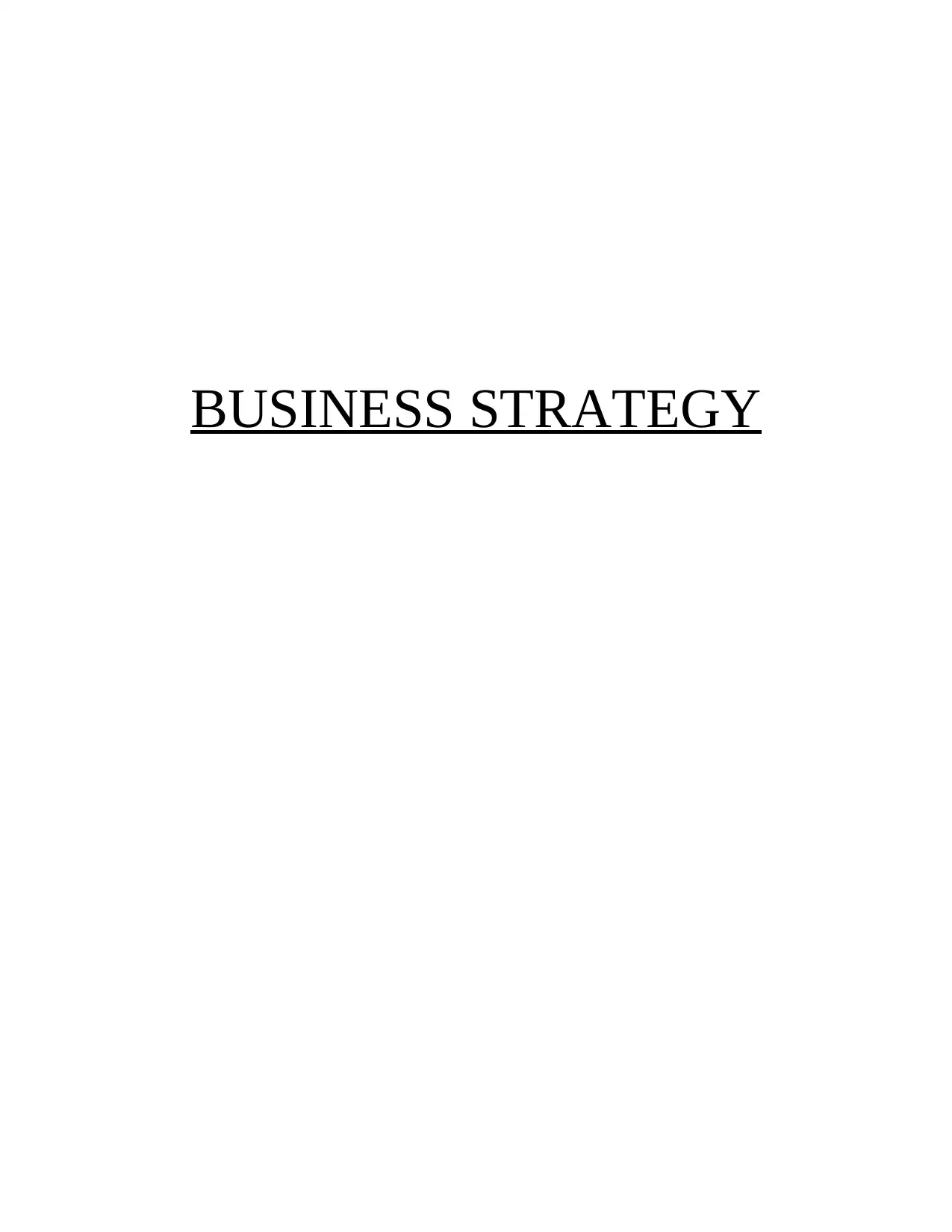
BUSINESS STRATEGY
Paraphrase This Document
Need a fresh take? Get an instant paraphrase of this document with our AI Paraphraser

TABLE OF CONTENTS
PART – 1.........................................................................................................................................4
P1. Impact and Influence of Macro Environment on Tesco and its Business Strategy...............4
P2. Organisational Internal Environment....................................................................................7
PART-2..........................................................................................................................................10
P3. Analysis of outcomes using Porter’s Five forces Model.....................................................10
P4. Models and Theories assisting in interpretation of Strategic Direction available to Tesco 11
CONCLUSION..............................................................................................................................14
REFERENCES................................................................................................................................1
PART – 1.........................................................................................................................................4
P1. Impact and Influence of Macro Environment on Tesco and its Business Strategy...............4
P2. Organisational Internal Environment....................................................................................7
PART-2..........................................................................................................................................10
P3. Analysis of outcomes using Porter’s Five forces Model.....................................................10
P4. Models and Theories assisting in interpretation of Strategic Direction available to Tesco 11
CONCLUSION..............................................................................................................................14
REFERENCES................................................................................................................................1

⊘ This is a preview!⊘
Do you want full access?
Subscribe today to unlock all pages.

Trusted by 1+ million students worldwide
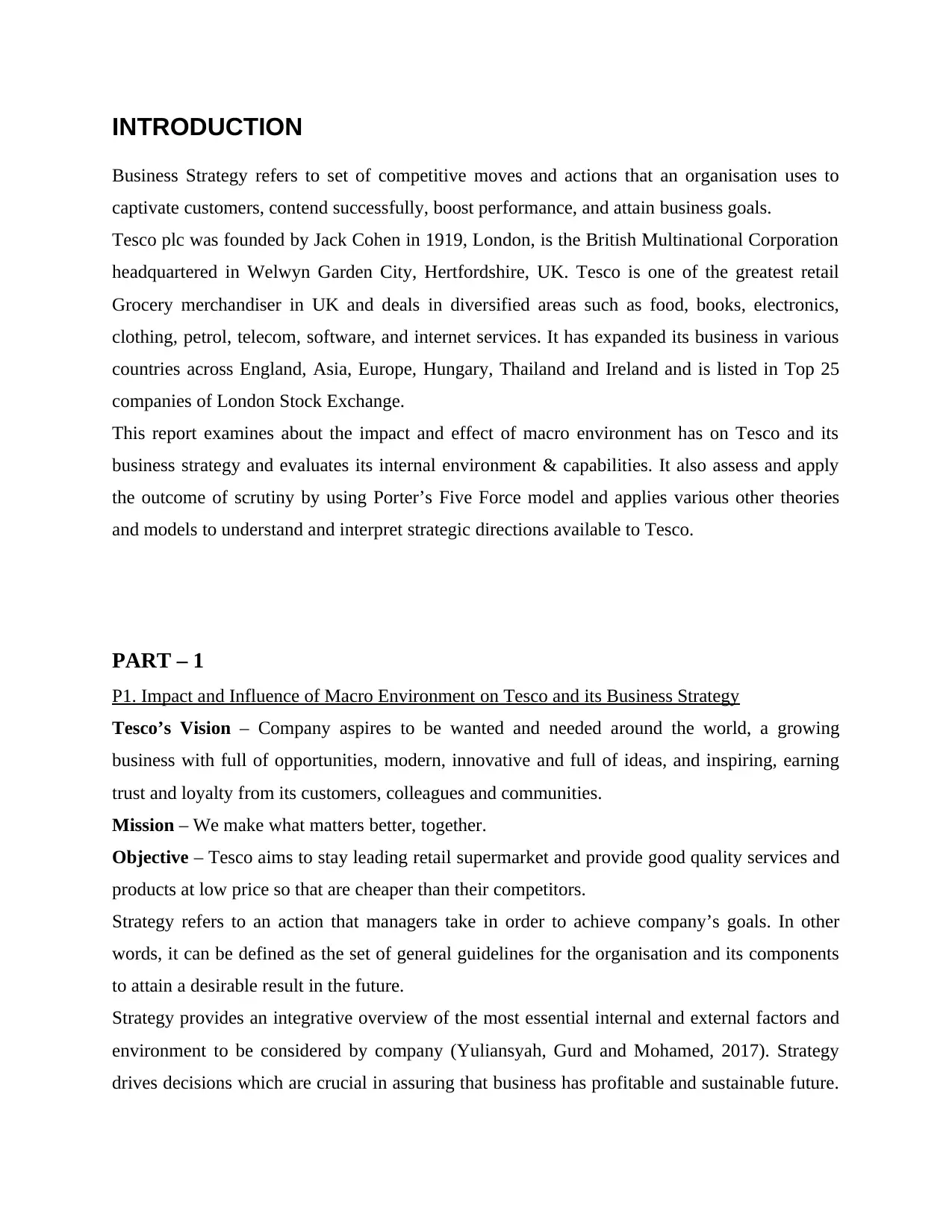
INTRODUCTION
Business Strategy refers to set of competitive moves and actions that an organisation uses to
captivate customers, contend successfully, boost performance, and attain business goals.
Tesco plc was founded by Jack Cohen in 1919, London, is the British Multinational Corporation
headquartered in Welwyn Garden City, Hertfordshire, UK. Tesco is one of the greatest retail
Grocery merchandiser in UK and deals in diversified areas such as food, books, electronics,
clothing, petrol, telecom, software, and internet services. It has expanded its business in various
countries across England, Asia, Europe, Hungary, Thailand and Ireland and is listed in Top 25
companies of London Stock Exchange.
This report examines about the impact and effect of macro environment has on Tesco and its
business strategy and evaluates its internal environment & capabilities. It also assess and apply
the outcome of scrutiny by using Porter’s Five Force model and applies various other theories
and models to understand and interpret strategic directions available to Tesco.
PART – 1
P1. Impact and Influence of Macro Environment on Tesco and its Business Strategy
Tesco’s Vision – Company aspires to be wanted and needed around the world, a growing
business with full of opportunities, modern, innovative and full of ideas, and inspiring, earning
trust and loyalty from its customers, colleagues and communities.
Mission – We make what matters better, together.
Objective – Tesco aims to stay leading retail supermarket and provide good quality services and
products at low price so that are cheaper than their competitors.
Strategy refers to an action that managers take in order to achieve company’s goals. In other
words, it can be defined as the set of general guidelines for the organisation and its components
to attain a desirable result in the future.
Strategy provides an integrative overview of the most essential internal and external factors and
environment to be considered by company (Yuliansyah, Gurd and Mohamed, 2017). Strategy
drives decisions which are crucial in assuring that business has profitable and sustainable future.
Business Strategy refers to set of competitive moves and actions that an organisation uses to
captivate customers, contend successfully, boost performance, and attain business goals.
Tesco plc was founded by Jack Cohen in 1919, London, is the British Multinational Corporation
headquartered in Welwyn Garden City, Hertfordshire, UK. Tesco is one of the greatest retail
Grocery merchandiser in UK and deals in diversified areas such as food, books, electronics,
clothing, petrol, telecom, software, and internet services. It has expanded its business in various
countries across England, Asia, Europe, Hungary, Thailand and Ireland and is listed in Top 25
companies of London Stock Exchange.
This report examines about the impact and effect of macro environment has on Tesco and its
business strategy and evaluates its internal environment & capabilities. It also assess and apply
the outcome of scrutiny by using Porter’s Five Force model and applies various other theories
and models to understand and interpret strategic directions available to Tesco.
PART – 1
P1. Impact and Influence of Macro Environment on Tesco and its Business Strategy
Tesco’s Vision – Company aspires to be wanted and needed around the world, a growing
business with full of opportunities, modern, innovative and full of ideas, and inspiring, earning
trust and loyalty from its customers, colleagues and communities.
Mission – We make what matters better, together.
Objective – Tesco aims to stay leading retail supermarket and provide good quality services and
products at low price so that are cheaper than their competitors.
Strategy refers to an action that managers take in order to achieve company’s goals. In other
words, it can be defined as the set of general guidelines for the organisation and its components
to attain a desirable result in the future.
Strategy provides an integrative overview of the most essential internal and external factors and
environment to be considered by company (Yuliansyah, Gurd and Mohamed, 2017). Strategy
drives decisions which are crucial in assuring that business has profitable and sustainable future.
Paraphrase This Document
Need a fresh take? Get an instant paraphrase of this document with our AI Paraphraser
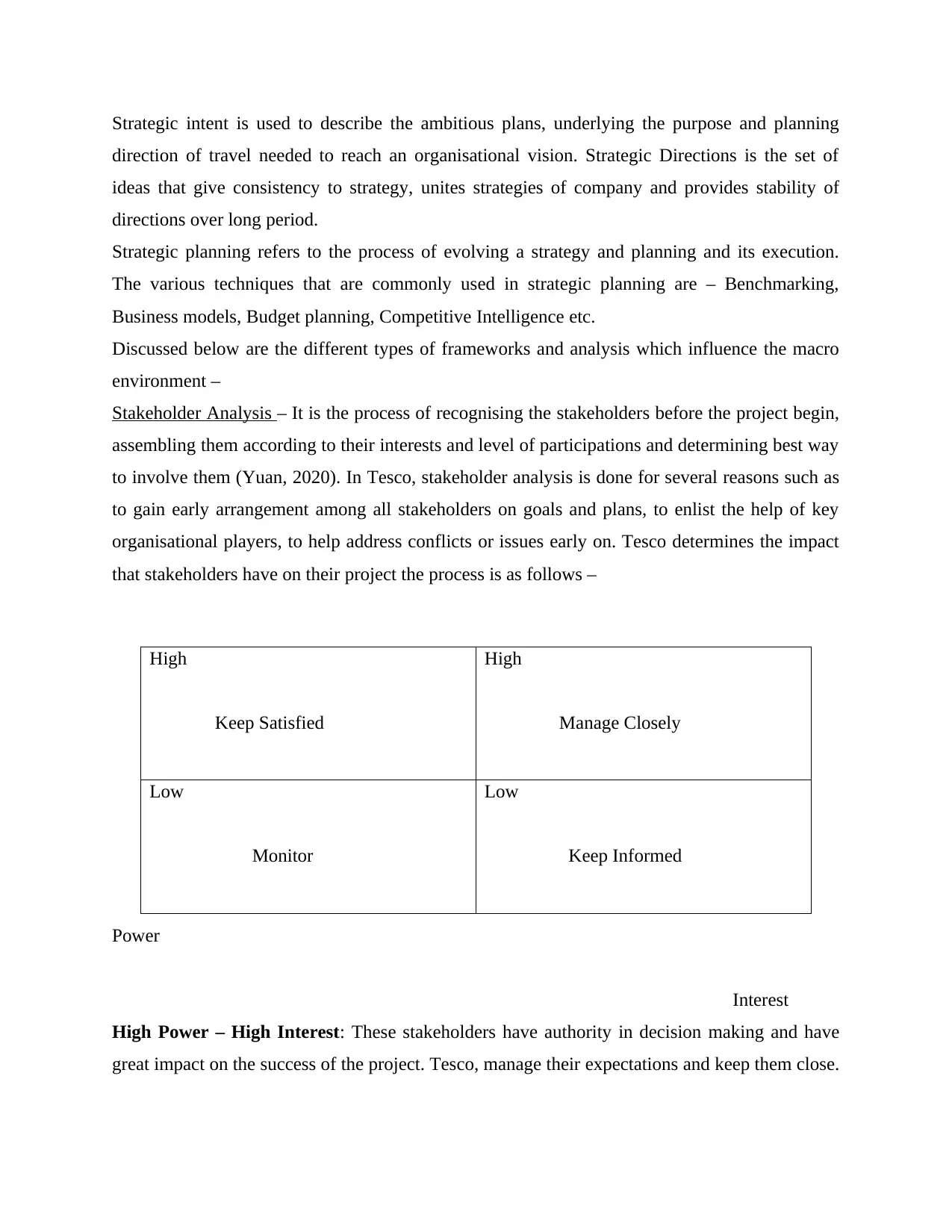
Strategic intent is used to describe the ambitious plans, underlying the purpose and planning
direction of travel needed to reach an organisational vision. Strategic Directions is the set of
ideas that give consistency to strategy, unites strategies of company and provides stability of
directions over long period.
Strategic planning refers to the process of evolving a strategy and planning and its execution.
The various techniques that are commonly used in strategic planning are – Benchmarking,
Business models, Budget planning, Competitive Intelligence etc.
Discussed below are the different types of frameworks and analysis which influence the macro
environment –
Stakeholder Analysis – It is the process of recognising the stakeholders before the project begin,
assembling them according to their interests and level of participations and determining best way
to involve them (Yuan, 2020). In Tesco, stakeholder analysis is done for several reasons such as
to gain early arrangement among all stakeholders on goals and plans, to enlist the help of key
organisational players, to help address conflicts or issues early on. Tesco determines the impact
that stakeholders have on their project the process is as follows –
Power
Interest
High Power – High Interest: These stakeholders have authority in decision making and have
great impact on the success of the project. Tesco, manage their expectations and keep them close.
High
Keep Satisfied
High
Manage Closely
Low
Monitor
Low
Keep Informed
direction of travel needed to reach an organisational vision. Strategic Directions is the set of
ideas that give consistency to strategy, unites strategies of company and provides stability of
directions over long period.
Strategic planning refers to the process of evolving a strategy and planning and its execution.
The various techniques that are commonly used in strategic planning are – Benchmarking,
Business models, Budget planning, Competitive Intelligence etc.
Discussed below are the different types of frameworks and analysis which influence the macro
environment –
Stakeholder Analysis – It is the process of recognising the stakeholders before the project begin,
assembling them according to their interests and level of participations and determining best way
to involve them (Yuan, 2020). In Tesco, stakeholder analysis is done for several reasons such as
to gain early arrangement among all stakeholders on goals and plans, to enlist the help of key
organisational players, to help address conflicts or issues early on. Tesco determines the impact
that stakeholders have on their project the process is as follows –
Power
Interest
High Power – High Interest: These stakeholders have authority in decision making and have
great impact on the success of the project. Tesco, manage their expectations and keep them close.
High
Keep Satisfied
High
Manage Closely
Low
Monitor
Low
Keep Informed
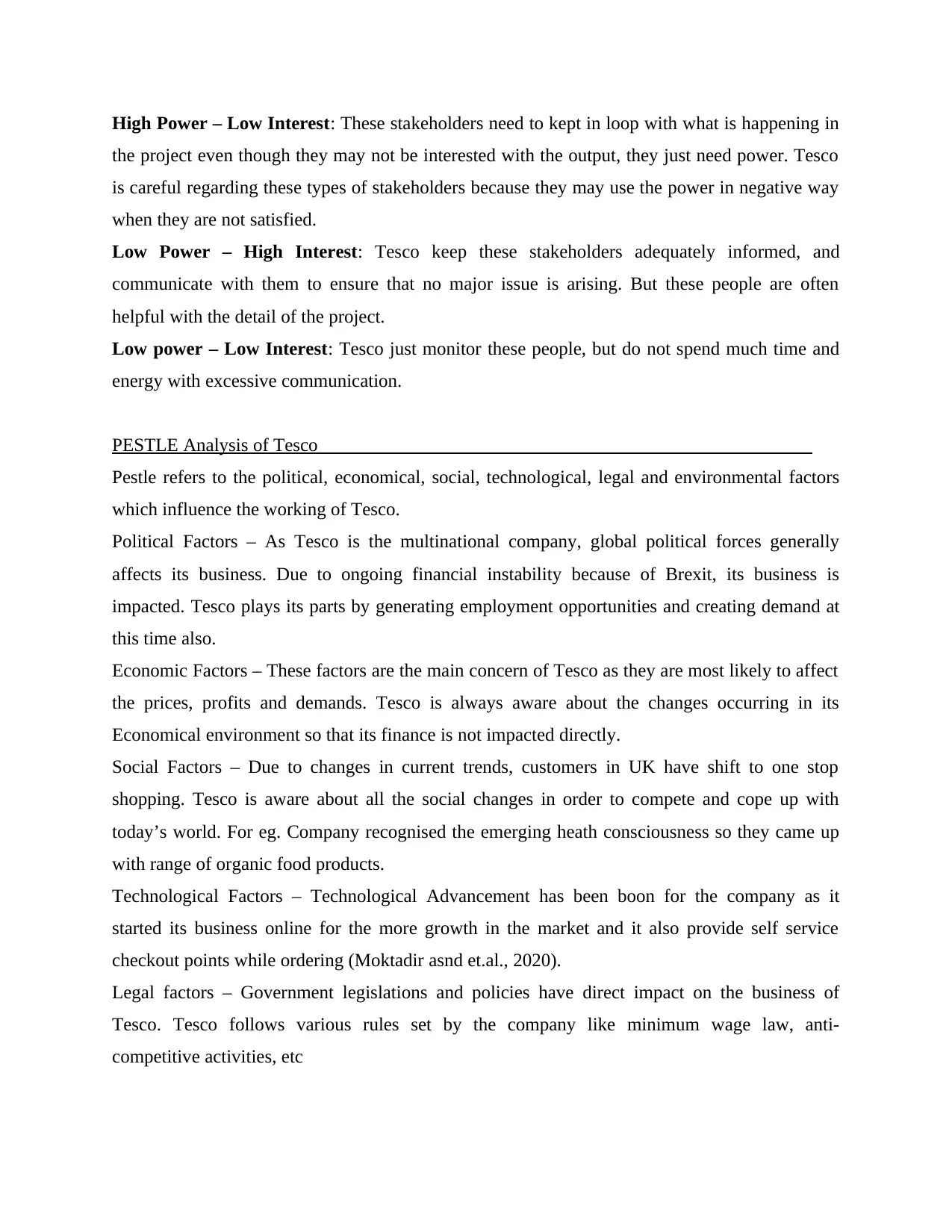
High Power – Low Interest: These stakeholders need to kept in loop with what is happening in
the project even though they may not be interested with the output, they just need power. Tesco
is careful regarding these types of stakeholders because they may use the power in negative way
when they are not satisfied.
Low Power – High Interest: Tesco keep these stakeholders adequately informed, and
communicate with them to ensure that no major issue is arising. But these people are often
helpful with the detail of the project.
Low power – Low Interest: Tesco just monitor these people, but do not spend much time and
energy with excessive communication.
PESTLE Analysis of Tesco
Pestle refers to the political, economical, social, technological, legal and environmental factors
which influence the working of Tesco.
Political Factors – As Tesco is the multinational company, global political forces generally
affects its business. Due to ongoing financial instability because of Brexit, its business is
impacted. Tesco plays its parts by generating employment opportunities and creating demand at
this time also.
Economic Factors – These factors are the main concern of Tesco as they are most likely to affect
the prices, profits and demands. Tesco is always aware about the changes occurring in its
Economical environment so that its finance is not impacted directly.
Social Factors – Due to changes in current trends, customers in UK have shift to one stop
shopping. Tesco is aware about all the social changes in order to compete and cope up with
today’s world. For eg. Company recognised the emerging heath consciousness so they came up
with range of organic food products.
Technological Factors – Technological Advancement has been boon for the company as it
started its business online for the more growth in the market and it also provide self service
checkout points while ordering (Moktadir asnd et.al., 2020).
Legal factors – Government legislations and policies have direct impact on the business of
Tesco. Tesco follows various rules set by the company like minimum wage law, anti-
competitive activities, etc
the project even though they may not be interested with the output, they just need power. Tesco
is careful regarding these types of stakeholders because they may use the power in negative way
when they are not satisfied.
Low Power – High Interest: Tesco keep these stakeholders adequately informed, and
communicate with them to ensure that no major issue is arising. But these people are often
helpful with the detail of the project.
Low power – Low Interest: Tesco just monitor these people, but do not spend much time and
energy with excessive communication.
PESTLE Analysis of Tesco
Pestle refers to the political, economical, social, technological, legal and environmental factors
which influence the working of Tesco.
Political Factors – As Tesco is the multinational company, global political forces generally
affects its business. Due to ongoing financial instability because of Brexit, its business is
impacted. Tesco plays its parts by generating employment opportunities and creating demand at
this time also.
Economic Factors – These factors are the main concern of Tesco as they are most likely to affect
the prices, profits and demands. Tesco is always aware about the changes occurring in its
Economical environment so that its finance is not impacted directly.
Social Factors – Due to changes in current trends, customers in UK have shift to one stop
shopping. Tesco is aware about all the social changes in order to compete and cope up with
today’s world. For eg. Company recognised the emerging heath consciousness so they came up
with range of organic food products.
Technological Factors – Technological Advancement has been boon for the company as it
started its business online for the more growth in the market and it also provide self service
checkout points while ordering (Moktadir asnd et.al., 2020).
Legal factors – Government legislations and policies have direct impact on the business of
Tesco. Tesco follows various rules set by the company like minimum wage law, anti-
competitive activities, etc
⊘ This is a preview!⊘
Do you want full access?
Subscribe today to unlock all pages.

Trusted by 1+ million students worldwide

Environmental Factors – There is lot of pressure from the public and government to address
environmental issues. To respond this issue Tesco has taken no. of initiatives one of it is they
have promised to remove 1 billion pieces of plastic packaging by the end of 2020.
SWOT Analysis of Tesco
Strength – Strength is what separates an organisation from its competitor. Tesco has a strong
brand image, loyal customer base, leading brand image, diversified market all these are the
strength which helps it to grow more.
Weakness – Weakness of the company stops it perform at its full potential. Tesco failed in
operations in few countries, fraud trial and accounting scandals, financial errors, clubcard
controversy are some of its weakness. Tesco regularly checks on its weakness and take steps and
measures to turn its weakness to strength.
Opportunities – Opportunities are the external factors which can provide company a competitive
advantage over its competitor. Tesco has recently expanded its jack business, it does joint
venture and strategic alliance with other companies and brands are some of the opportunities
which can give Tesco future growth.
Threat – Threats are the components which can likely harm the growth of the company.
Christmas add controversy, Brexit referendum, economic crisis, fake harm legal threats harms
the Tesco’s reputation in the market and hinders its growth.
P2. Organisational Internal Environment
Strategic Capabilities denotes to company’s ability to tackle all its resources, skills and
capabilities so as to have competitive advantage. Two components of strategic capabilities are –
resources and competences. Resources are the assets that company has and Competence are the
ways those assets are position efficiently.
Mckinsey 7s Model
The Mckinsey 7s Model was developed by Tom Peter and Robert Waterman at Mckinsey
suggest that the model helps in facilitating organisational change, aligning new strategies, aiding
merger and acquisitions, Improving the performance of the company etc. The model has hard
elements such as - Strategy, Structure and Systems and soft elements such as Shared values,
skills, staff and style.
environmental issues. To respond this issue Tesco has taken no. of initiatives one of it is they
have promised to remove 1 billion pieces of plastic packaging by the end of 2020.
SWOT Analysis of Tesco
Strength – Strength is what separates an organisation from its competitor. Tesco has a strong
brand image, loyal customer base, leading brand image, diversified market all these are the
strength which helps it to grow more.
Weakness – Weakness of the company stops it perform at its full potential. Tesco failed in
operations in few countries, fraud trial and accounting scandals, financial errors, clubcard
controversy are some of its weakness. Tesco regularly checks on its weakness and take steps and
measures to turn its weakness to strength.
Opportunities – Opportunities are the external factors which can provide company a competitive
advantage over its competitor. Tesco has recently expanded its jack business, it does joint
venture and strategic alliance with other companies and brands are some of the opportunities
which can give Tesco future growth.
Threat – Threats are the components which can likely harm the growth of the company.
Christmas add controversy, Brexit referendum, economic crisis, fake harm legal threats harms
the Tesco’s reputation in the market and hinders its growth.
P2. Organisational Internal Environment
Strategic Capabilities denotes to company’s ability to tackle all its resources, skills and
capabilities so as to have competitive advantage. Two components of strategic capabilities are –
resources and competences. Resources are the assets that company has and Competence are the
ways those assets are position efficiently.
Mckinsey 7s Model
The Mckinsey 7s Model was developed by Tom Peter and Robert Waterman at Mckinsey
suggest that the model helps in facilitating organisational change, aligning new strategies, aiding
merger and acquisitions, Improving the performance of the company etc. The model has hard
elements such as - Strategy, Structure and Systems and soft elements such as Shared values,
skills, staff and style.
Paraphrase This Document
Need a fresh take? Get an instant paraphrase of this document with our AI Paraphraser
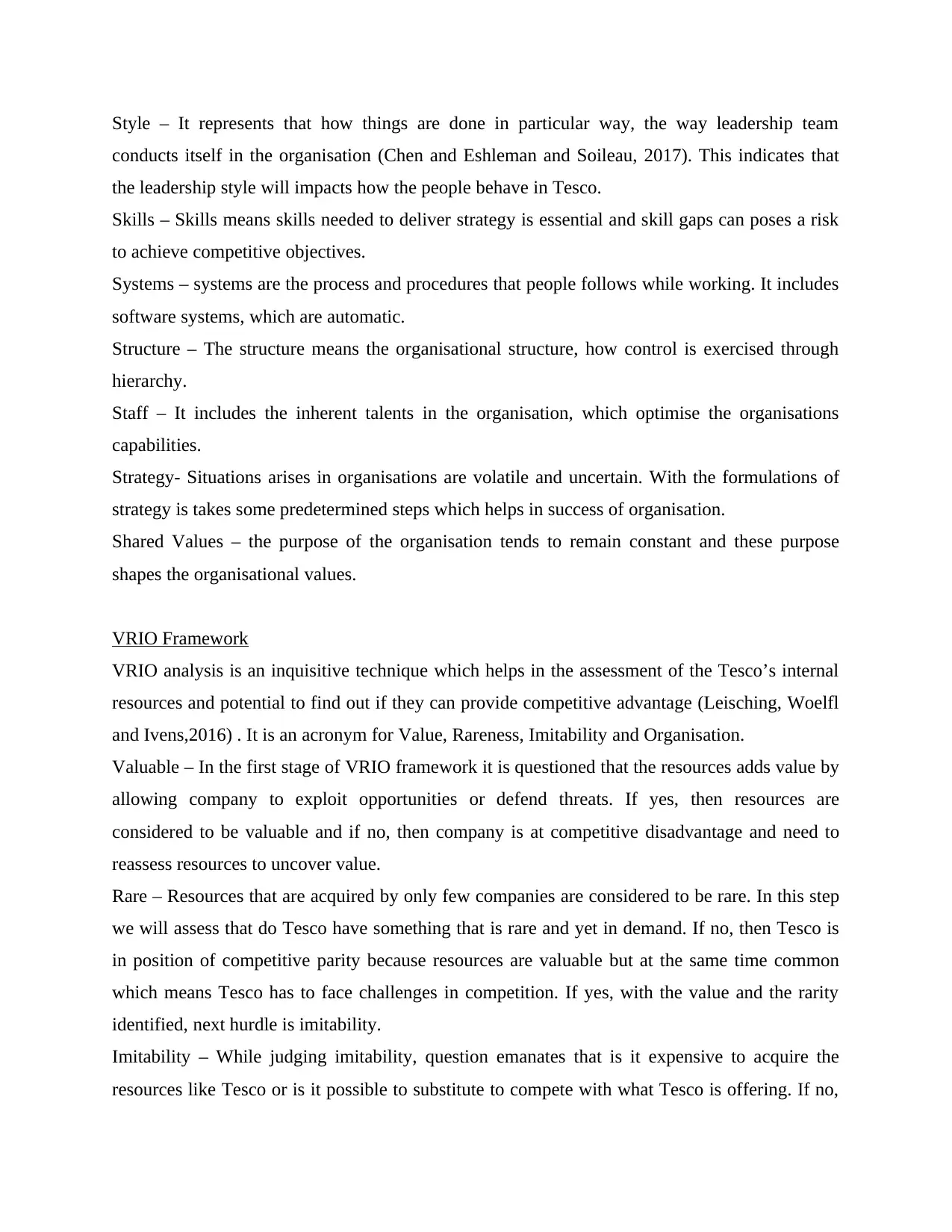
Style – It represents that how things are done in particular way, the way leadership team
conducts itself in the organisation (Chen and Eshleman and Soileau, 2017). This indicates that
the leadership style will impacts how the people behave in Tesco.
Skills – Skills means skills needed to deliver strategy is essential and skill gaps can poses a risk
to achieve competitive objectives.
Systems – systems are the process and procedures that people follows while working. It includes
software systems, which are automatic.
Structure – The structure means the organisational structure, how control is exercised through
hierarchy.
Staff – It includes the inherent talents in the organisation, which optimise the organisations
capabilities.
Strategy- Situations arises in organisations are volatile and uncertain. With the formulations of
strategy is takes some predetermined steps which helps in success of organisation.
Shared Values – the purpose of the organisation tends to remain constant and these purpose
shapes the organisational values.
VRIO Framework
VRIO analysis is an inquisitive technique which helps in the assessment of the Tesco’s internal
resources and potential to find out if they can provide competitive advantage (Leisching, Woelfl
and Ivens,2016) . It is an acronym for Value, Rareness, Imitability and Organisation.
Valuable – In the first stage of VRIO framework it is questioned that the resources adds value by
allowing company to exploit opportunities or defend threats. If yes, then resources are
considered to be valuable and if no, then company is at competitive disadvantage and need to
reassess resources to uncover value.
Rare – Resources that are acquired by only few companies are considered to be rare. In this step
we will assess that do Tesco have something that is rare and yet in demand. If no, then Tesco is
in position of competitive parity because resources are valuable but at the same time common
which means Tesco has to face challenges in competition. If yes, with the value and the rarity
identified, next hurdle is imitability.
Imitability – While judging imitability, question emanates that is it expensive to acquire the
resources like Tesco or is it possible to substitute to compete with what Tesco is offering. If no,
conducts itself in the organisation (Chen and Eshleman and Soileau, 2017). This indicates that
the leadership style will impacts how the people behave in Tesco.
Skills – Skills means skills needed to deliver strategy is essential and skill gaps can poses a risk
to achieve competitive objectives.
Systems – systems are the process and procedures that people follows while working. It includes
software systems, which are automatic.
Structure – The structure means the organisational structure, how control is exercised through
hierarchy.
Staff – It includes the inherent talents in the organisation, which optimise the organisations
capabilities.
Strategy- Situations arises in organisations are volatile and uncertain. With the formulations of
strategy is takes some predetermined steps which helps in success of organisation.
Shared Values – the purpose of the organisation tends to remain constant and these purpose
shapes the organisational values.
VRIO Framework
VRIO analysis is an inquisitive technique which helps in the assessment of the Tesco’s internal
resources and potential to find out if they can provide competitive advantage (Leisching, Woelfl
and Ivens,2016) . It is an acronym for Value, Rareness, Imitability and Organisation.
Valuable – In the first stage of VRIO framework it is questioned that the resources adds value by
allowing company to exploit opportunities or defend threats. If yes, then resources are
considered to be valuable and if no, then company is at competitive disadvantage and need to
reassess resources to uncover value.
Rare – Resources that are acquired by only few companies are considered to be rare. In this step
we will assess that do Tesco have something that is rare and yet in demand. If no, then Tesco is
in position of competitive parity because resources are valuable but at the same time common
which means Tesco has to face challenges in competition. If yes, with the value and the rarity
identified, next hurdle is imitability.
Imitability – While judging imitability, question emanates that is it expensive to acquire the
resources like Tesco or is it possible to substitute to compete with what Tesco is offering. If no,

then company has temporary competitive advantage, it will lead Tesco ahead from its
competitors. If yes, means Tesco offers something rare, valuable and imitate.
Organisation – Tesco’s resources will not confer any advantage if they are not organised that
value can be realised from them. Tesco can sustain competitive advantage only when it has
organised management, procedures, policies, structure, process and culture.
Value Chain Analysis –
Value chain analysis is the process for business to evaluate the activities they perform to produce
a product (Bently, Newton and Thompson, 2017). Value chain analysis helps Tesco in
identifying its primary and assistance activities which adds value to its end product. Primary
Activities include Inbound Logistics, Operations, Outbound Logistics, Marketing and sales and
services. Support Activities include Firm infrastructure, HRM, Procurement and Technology
Development.
Inbound Activities – In Tesco, this is the primary stage where materials and resources are
acquired so that final goods and services can be developed.
Operations – Operations is how the resources and raw materials are fabricated, resulting into
final goods and services.
Outbound Logistics – In Tesco, once the goods and services are developed into finished goods, it
needs to be distributed. Delivery and distribution services process is known as outbound
services.
Marketing and Services – This is how Tesco presents and sells the product and services in UK
market.
Services – Services means support services that Tesco provides to its customers like guarantees,
warranties etc.
Business Infrastructure – It is belongs to the Support activities of Tesco, it involves the financial,
legal and all management systems to make decisions and manage its resources effectively.
Human Resource Management – For Tesco, having best talents and managing and hiring good
workforce is very essential because it gives competitive advantage.
Technology – Technological Advancement helps Tesco to innovate and bring new services and
ease value chain to gain advantage over competitior.
competitors. If yes, means Tesco offers something rare, valuable and imitate.
Organisation – Tesco’s resources will not confer any advantage if they are not organised that
value can be realised from them. Tesco can sustain competitive advantage only when it has
organised management, procedures, policies, structure, process and culture.
Value Chain Analysis –
Value chain analysis is the process for business to evaluate the activities they perform to produce
a product (Bently, Newton and Thompson, 2017). Value chain analysis helps Tesco in
identifying its primary and assistance activities which adds value to its end product. Primary
Activities include Inbound Logistics, Operations, Outbound Logistics, Marketing and sales and
services. Support Activities include Firm infrastructure, HRM, Procurement and Technology
Development.
Inbound Activities – In Tesco, this is the primary stage where materials and resources are
acquired so that final goods and services can be developed.
Operations – Operations is how the resources and raw materials are fabricated, resulting into
final goods and services.
Outbound Logistics – In Tesco, once the goods and services are developed into finished goods, it
needs to be distributed. Delivery and distribution services process is known as outbound
services.
Marketing and Services – This is how Tesco presents and sells the product and services in UK
market.
Services – Services means support services that Tesco provides to its customers like guarantees,
warranties etc.
Business Infrastructure – It is belongs to the Support activities of Tesco, it involves the financial,
legal and all management systems to make decisions and manage its resources effectively.
Human Resource Management – For Tesco, having best talents and managing and hiring good
workforce is very essential because it gives competitive advantage.
Technology – Technological Advancement helps Tesco to innovate and bring new services and
ease value chain to gain advantage over competitior.
⊘ This is a preview!⊘
Do you want full access?
Subscribe today to unlock all pages.

Trusted by 1+ million students worldwide
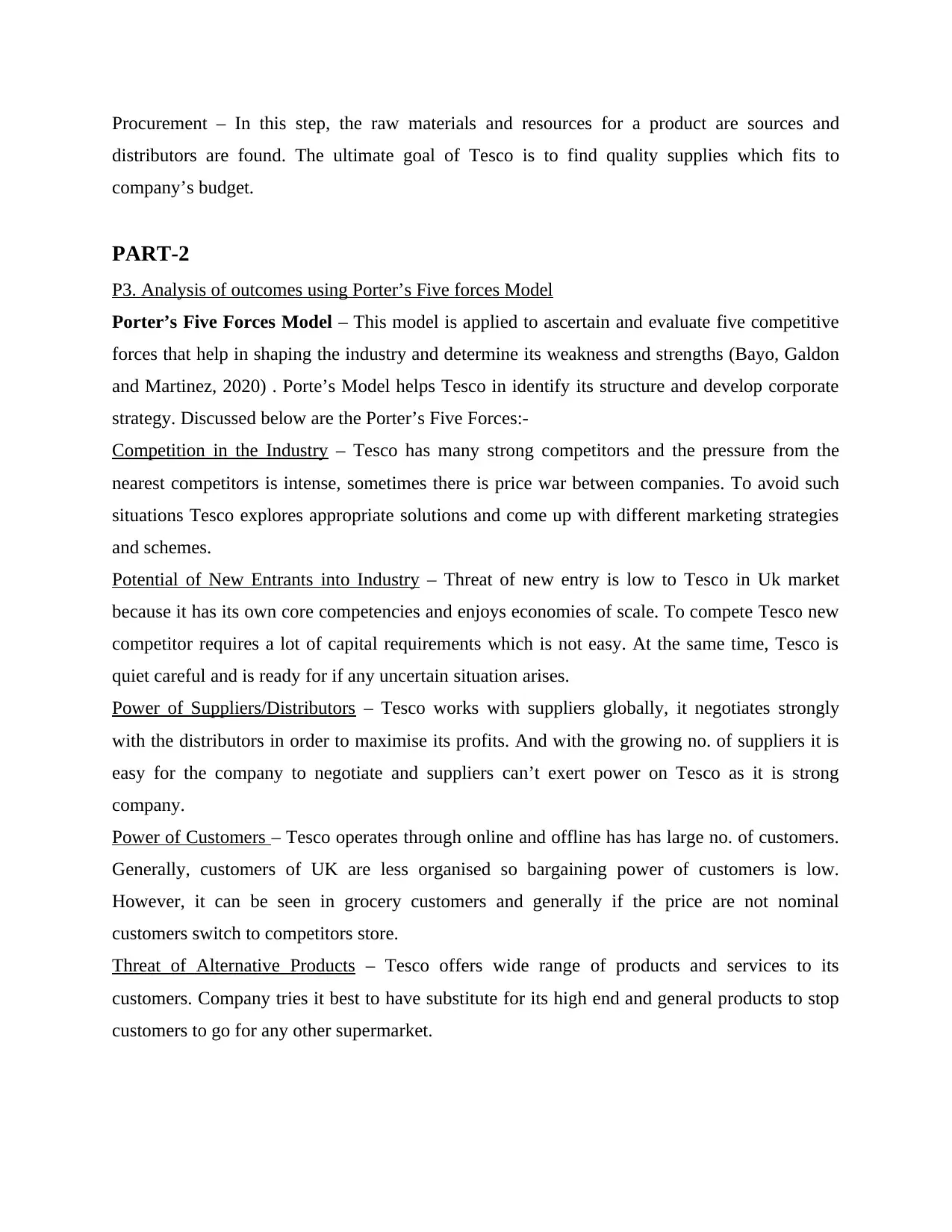
Procurement – In this step, the raw materials and resources for a product are sources and
distributors are found. The ultimate goal of Tesco is to find quality supplies which fits to
company’s budget.
PART-2
P3. Analysis of outcomes using Porter’s Five forces Model
Porter’s Five Forces Model – This model is applied to ascertain and evaluate five competitive
forces that help in shaping the industry and determine its weakness and strengths (Bayo, Galdon
and Martinez, 2020) . Porte’s Model helps Tesco in identify its structure and develop corporate
strategy. Discussed below are the Porter’s Five Forces:-
Competition in the Industry – Tesco has many strong competitors and the pressure from the
nearest competitors is intense, sometimes there is price war between companies. To avoid such
situations Tesco explores appropriate solutions and come up with different marketing strategies
and schemes.
Potential of New Entrants into Industry – Threat of new entry is low to Tesco in Uk market
because it has its own core competencies and enjoys economies of scale. To compete Tesco new
competitor requires a lot of capital requirements which is not easy. At the same time, Tesco is
quiet careful and is ready for if any uncertain situation arises.
Power of Suppliers/Distributors – Tesco works with suppliers globally, it negotiates strongly
with the distributors in order to maximise its profits. And with the growing no. of suppliers it is
easy for the company to negotiate and suppliers can’t exert power on Tesco as it is strong
company.
Power of Customers – Tesco operates through online and offline has has large no. of customers.
Generally, customers of UK are less organised so bargaining power of customers is low.
However, it can be seen in grocery customers and generally if the price are not nominal
customers switch to competitors store.
Threat of Alternative Products – Tesco offers wide range of products and services to its
customers. Company tries it best to have substitute for its high end and general products to stop
customers to go for any other supermarket.
distributors are found. The ultimate goal of Tesco is to find quality supplies which fits to
company’s budget.
PART-2
P3. Analysis of outcomes using Porter’s Five forces Model
Porter’s Five Forces Model – This model is applied to ascertain and evaluate five competitive
forces that help in shaping the industry and determine its weakness and strengths (Bayo, Galdon
and Martinez, 2020) . Porte’s Model helps Tesco in identify its structure and develop corporate
strategy. Discussed below are the Porter’s Five Forces:-
Competition in the Industry – Tesco has many strong competitors and the pressure from the
nearest competitors is intense, sometimes there is price war between companies. To avoid such
situations Tesco explores appropriate solutions and come up with different marketing strategies
and schemes.
Potential of New Entrants into Industry – Threat of new entry is low to Tesco in Uk market
because it has its own core competencies and enjoys economies of scale. To compete Tesco new
competitor requires a lot of capital requirements which is not easy. At the same time, Tesco is
quiet careful and is ready for if any uncertain situation arises.
Power of Suppliers/Distributors – Tesco works with suppliers globally, it negotiates strongly
with the distributors in order to maximise its profits. And with the growing no. of suppliers it is
easy for the company to negotiate and suppliers can’t exert power on Tesco as it is strong
company.
Power of Customers – Tesco operates through online and offline has has large no. of customers.
Generally, customers of UK are less organised so bargaining power of customers is low.
However, it can be seen in grocery customers and generally if the price are not nominal
customers switch to competitors store.
Threat of Alternative Products – Tesco offers wide range of products and services to its
customers. Company tries it best to have substitute for its high end and general products to stop
customers to go for any other supermarket.
Paraphrase This Document
Need a fresh take? Get an instant paraphrase of this document with our AI Paraphraser
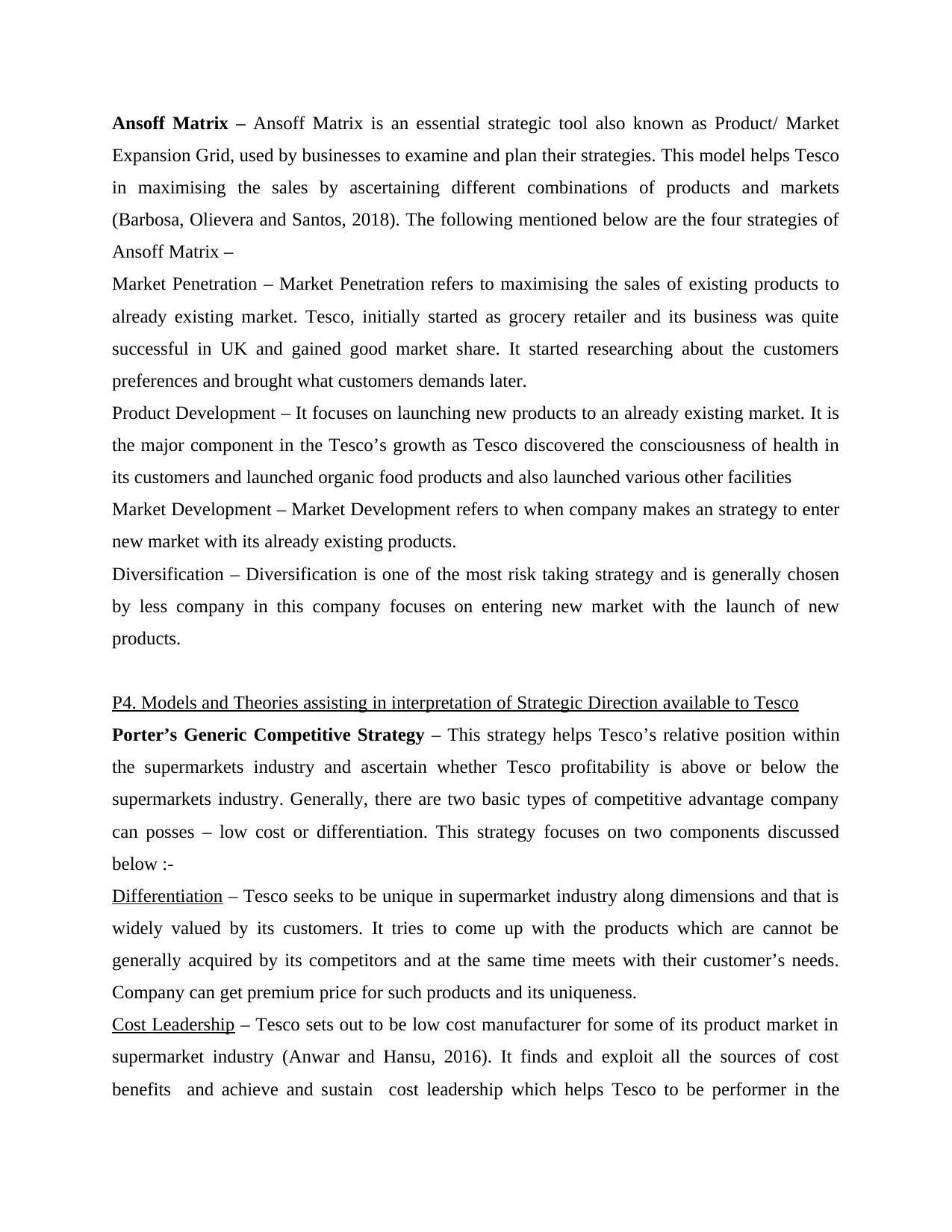
Ansoff Matrix – Ansoff Matrix is an essential strategic tool also known as Product/ Market
Expansion Grid, used by businesses to examine and plan their strategies. This model helps Tesco
in maximising the sales by ascertaining different combinations of products and markets
(Barbosa, Olievera and Santos, 2018). The following mentioned below are the four strategies of
Ansoff Matrix –
Market Penetration – Market Penetration refers to maximising the sales of existing products to
already existing market. Tesco, initially started as grocery retailer and its business was quite
successful in UK and gained good market share. It started researching about the customers
preferences and brought what customers demands later.
Product Development – It focuses on launching new products to an already existing market. It is
the major component in the Tesco’s growth as Tesco discovered the consciousness of health in
its customers and launched organic food products and also launched various other facilities
Market Development – Market Development refers to when company makes an strategy to enter
new market with its already existing products.
Diversification – Diversification is one of the most risk taking strategy and is generally chosen
by less company in this company focuses on entering new market with the launch of new
products.
P4. Models and Theories assisting in interpretation of Strategic Direction available to Tesco
Porter’s Generic Competitive Strategy – This strategy helps Tesco’s relative position within
the supermarkets industry and ascertain whether Tesco profitability is above or below the
supermarkets industry. Generally, there are two basic types of competitive advantage company
can posses – low cost or differentiation. This strategy focuses on two components discussed
below :-
Differentiation – Tesco seeks to be unique in supermarket industry along dimensions and that is
widely valued by its customers. It tries to come up with the products which are cannot be
generally acquired by its competitors and at the same time meets with their customer’s needs.
Company can get premium price for such products and its uniqueness.
Cost Leadership – Tesco sets out to be low cost manufacturer for some of its product market in
supermarket industry (Anwar and Hansu, 2016). It finds and exploit all the sources of cost
benefits and achieve and sustain cost leadership which helps Tesco to be performer in the
Expansion Grid, used by businesses to examine and plan their strategies. This model helps Tesco
in maximising the sales by ascertaining different combinations of products and markets
(Barbosa, Olievera and Santos, 2018). The following mentioned below are the four strategies of
Ansoff Matrix –
Market Penetration – Market Penetration refers to maximising the sales of existing products to
already existing market. Tesco, initially started as grocery retailer and its business was quite
successful in UK and gained good market share. It started researching about the customers
preferences and brought what customers demands later.
Product Development – It focuses on launching new products to an already existing market. It is
the major component in the Tesco’s growth as Tesco discovered the consciousness of health in
its customers and launched organic food products and also launched various other facilities
Market Development – Market Development refers to when company makes an strategy to enter
new market with its already existing products.
Diversification – Diversification is one of the most risk taking strategy and is generally chosen
by less company in this company focuses on entering new market with the launch of new
products.
P4. Models and Theories assisting in interpretation of Strategic Direction available to Tesco
Porter’s Generic Competitive Strategy – This strategy helps Tesco’s relative position within
the supermarkets industry and ascertain whether Tesco profitability is above or below the
supermarkets industry. Generally, there are two basic types of competitive advantage company
can posses – low cost or differentiation. This strategy focuses on two components discussed
below :-
Differentiation – Tesco seeks to be unique in supermarket industry along dimensions and that is
widely valued by its customers. It tries to come up with the products which are cannot be
generally acquired by its competitors and at the same time meets with their customer’s needs.
Company can get premium price for such products and its uniqueness.
Cost Leadership – Tesco sets out to be low cost manufacturer for some of its product market in
supermarket industry (Anwar and Hansu, 2016). It finds and exploit all the sources of cost
benefits and achieve and sustain cost leadership which helps Tesco to be performer in the
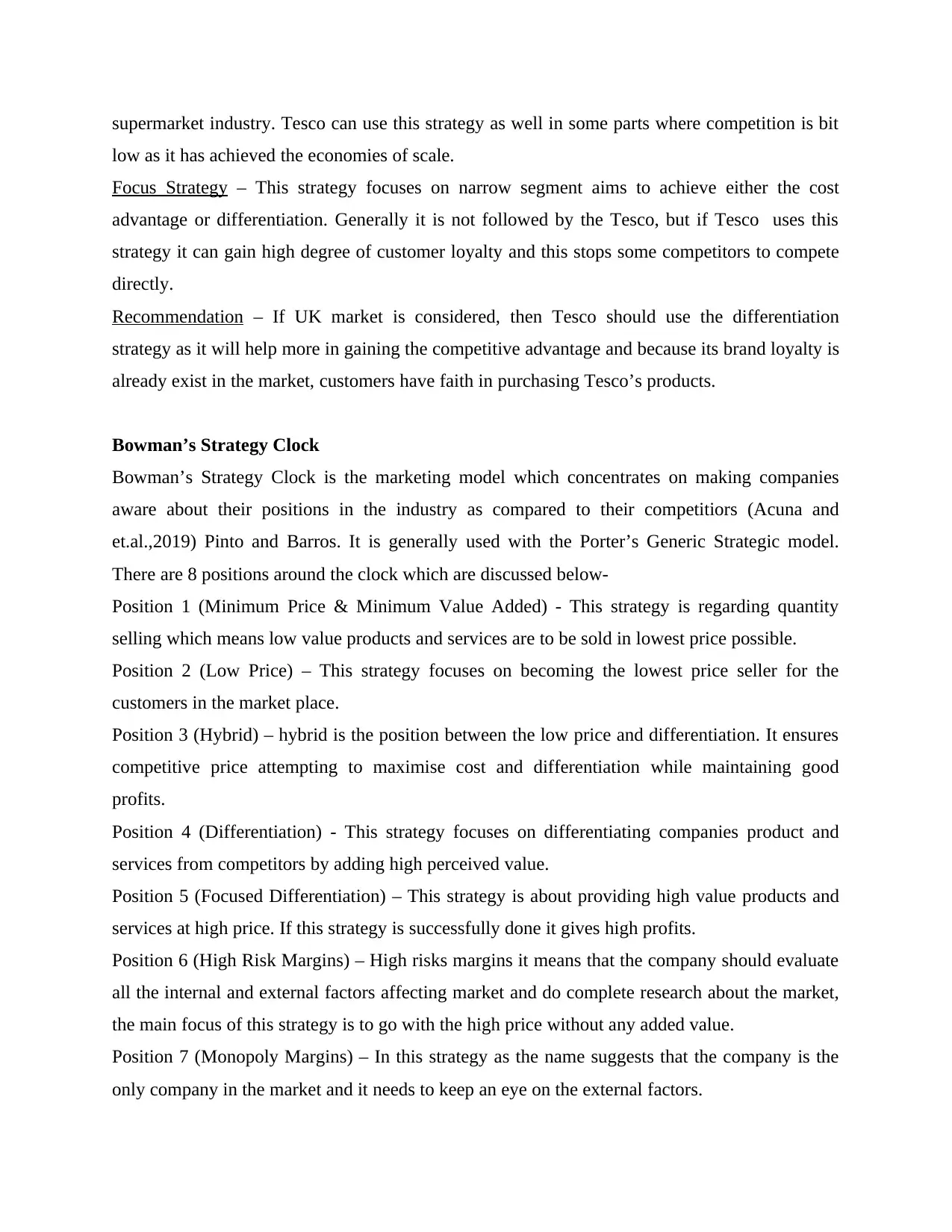
supermarket industry. Tesco can use this strategy as well in some parts where competition is bit
low as it has achieved the economies of scale.
Focus Strategy – This strategy focuses on narrow segment aims to achieve either the cost
advantage or differentiation. Generally it is not followed by the Tesco, but if Tesco uses this
strategy it can gain high degree of customer loyalty and this stops some competitors to compete
directly.
Recommendation – If UK market is considered, then Tesco should use the differentiation
strategy as it will help more in gaining the competitive advantage and because its brand loyalty is
already exist in the market, customers have faith in purchasing Tesco’s products.
Bowman’s Strategy Clock
Bowman’s Strategy Clock is the marketing model which concentrates on making companies
aware about their positions in the industry as compared to their competitiors (Acuna and
et.al.,2019) Pinto and Barros. It is generally used with the Porter’s Generic Strategic model.
There are 8 positions around the clock which are discussed below-
Position 1 (Minimum Price & Minimum Value Added) - This strategy is regarding quantity
selling which means low value products and services are to be sold in lowest price possible.
Position 2 (Low Price) – This strategy focuses on becoming the lowest price seller for the
customers in the market place.
Position 3 (Hybrid) – hybrid is the position between the low price and differentiation. It ensures
competitive price attempting to maximise cost and differentiation while maintaining good
profits.
Position 4 (Differentiation) - This strategy focuses on differentiating companies product and
services from competitors by adding high perceived value.
Position 5 (Focused Differentiation) – This strategy is about providing high value products and
services at high price. If this strategy is successfully done it gives high profits.
Position 6 (High Risk Margins) – High risks margins it means that the company should evaluate
all the internal and external factors affecting market and do complete research about the market,
the main focus of this strategy is to go with the high price without any added value.
Position 7 (Monopoly Margins) – In this strategy as the name suggests that the company is the
only company in the market and it needs to keep an eye on the external factors.
low as it has achieved the economies of scale.
Focus Strategy – This strategy focuses on narrow segment aims to achieve either the cost
advantage or differentiation. Generally it is not followed by the Tesco, but if Tesco uses this
strategy it can gain high degree of customer loyalty and this stops some competitors to compete
directly.
Recommendation – If UK market is considered, then Tesco should use the differentiation
strategy as it will help more in gaining the competitive advantage and because its brand loyalty is
already exist in the market, customers have faith in purchasing Tesco’s products.
Bowman’s Strategy Clock
Bowman’s Strategy Clock is the marketing model which concentrates on making companies
aware about their positions in the industry as compared to their competitiors (Acuna and
et.al.,2019) Pinto and Barros. It is generally used with the Porter’s Generic Strategic model.
There are 8 positions around the clock which are discussed below-
Position 1 (Minimum Price & Minimum Value Added) - This strategy is regarding quantity
selling which means low value products and services are to be sold in lowest price possible.
Position 2 (Low Price) – This strategy focuses on becoming the lowest price seller for the
customers in the market place.
Position 3 (Hybrid) – hybrid is the position between the low price and differentiation. It ensures
competitive price attempting to maximise cost and differentiation while maintaining good
profits.
Position 4 (Differentiation) - This strategy focuses on differentiating companies product and
services from competitors by adding high perceived value.
Position 5 (Focused Differentiation) – This strategy is about providing high value products and
services at high price. If this strategy is successfully done it gives high profits.
Position 6 (High Risk Margins) – High risks margins it means that the company should evaluate
all the internal and external factors affecting market and do complete research about the market,
the main focus of this strategy is to go with the high price without any added value.
Position 7 (Monopoly Margins) – In this strategy as the name suggests that the company is the
only company in the market and it needs to keep an eye on the external factors.
⊘ This is a preview!⊘
Do you want full access?
Subscribe today to unlock all pages.

Trusted by 1+ million students worldwide
1 out of 17
Related Documents
Your All-in-One AI-Powered Toolkit for Academic Success.
+13062052269
info@desklib.com
Available 24*7 on WhatsApp / Email
![[object Object]](/_next/static/media/star-bottom.7253800d.svg)
Unlock your academic potential
Copyright © 2020–2025 A2Z Services. All Rights Reserved. Developed and managed by ZUCOL.




